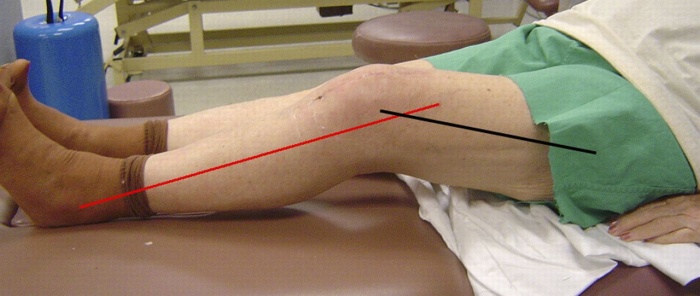Knee Extension Lag
Original Editor - Ajay Upadhyay
Top Contributors - Laura Ritchie, Kim Jackson, Ajay Upadhyay, Nehal Shah, Evan Thomas, WikiSysop, Wanda van Niekerk, Lauren Lopez and AdminIntroduction[edit | edit source]
When a muscle is not able to actively move a joint to its passive limit, it is known as Muscle lag[1].
Passive and Active limit of a joint[edit | edit source]
PASSIVE LIMIT - While moving a joint, passive limit should be obtained by exerting mild force against resistance from joint stiffness or soft tissue tightness and that does not produce any discomfort[1].
ACTIVE LIMIT - Active limit of a joint is obtained when the moving segment of the patient is resisted by gravity. The patient position should be such that there is no external load on the moving segment except gravity.[1]
Purpose[edit | edit source]
The term ‘muscle lag’ or ‘extensor lag’ or ‘quadriceps lag’ is a clinical sign with often profound functional relevance for patients during knee rehabilitation.
Technique[edit | edit source]
Muscle lag is an inability to actively move a joint to its passive limit. In more detail, the passive limit should be the passive limit that can be achieved without producing significant discomfort, and without exerting more than mild force against resistance from joint stiffness or other soft tissue tightness. The active limit should be determined with the patient positioned so that the moving segment is resisted by gravity but no other external load. [2]
Active Lag Test[edit | edit source]
An active lag is determined by the inability of the erectly seated subject to actively extend the involved knee in maximal dorsiflexion of the ankle to the same level as the normal knee held in maximal extension and ankle in maximal dorsiflexion, as seen by the levels of the toes.
Passive Lag Test[edit | edit source]
A passive lag is determined by placing the subject prone with the knees just past the edge of the table and determining the high position of the heel in a fully resting extension position compared to the heel on the normal side.
It appears there is a widespread belief that lag is always abnormal.
Physiological Quadriceps Lag[edit | edit source]
| [3] |
A study done on physiological quadriceps lag has shown that most healthy young adults, when assessed in the manner described, manifest a quadriceps lag. [2] At the instant of maximum voluntary active extension, 48% of the 64 subjects had a quadriceps lag of between 2.0 and 10.5 degrees. Since these subjects had no pain, and further passive extension was possible without substantial passive resistance, this lag at 0 sec can only be readily explained as a manifestation of normal quadriceps femoris active insufficiency, perhaps augmented in some subjects by a less than maximum voluntary effort. The apparent absence of any reference in the literature to quadriceps lag in normal knees is most likely because quadriceps lag does not appear to have been examined systematically in healthy subjects.
Evidence[edit | edit source]
For the sitting active lag test, the inter-rater reliability was 'good' (Kappa 0.792, SE of kappa 0.115, 95% confidence interval). For the prone passive lag test, the inter-rater reliability was 'good' (Kappa 0.636, SE of kappa 0.136, 95% confidence interval). [2]
References[edit | edit source]
- ↑ 1.0 1.1 1.2 Stillman BC. Physiological quadriceps lag: its nature and clinical significance. Australian journal of physiotherapy. 2004 Jan 1;50(4):237-41.
- ↑ 2.0 2.1 2.2 Sebastian D, Chovvath R, Malladi R. The sitting active and prone passive lag test: an inter-rater reliability study.J Bodyw Mov Ther. 2014 Apr;18(2):204-9.
- ↑ Tim Richardson. Physical Therapy Diagnosis: Supine Quadriceps lag. Available from: http://www.youtube.com/watch?v=CZK-j5VXo-I [last accessed 21/09/14]








